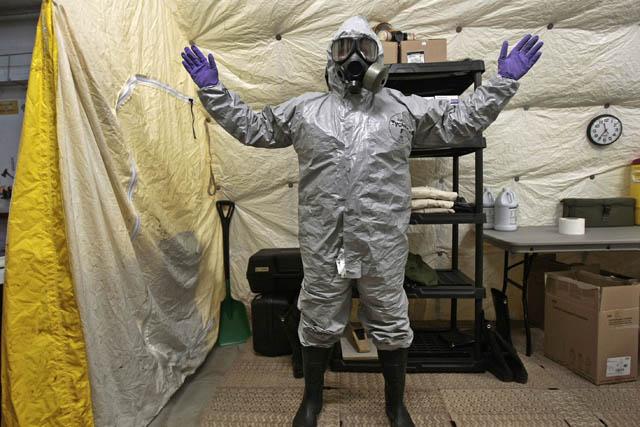You are here
Destruction of Syrian chemicals a work in progress
By AP - May 28,2014 - Last updated at May 28,2014
THE HAGUE — In just over a month, Syria is supposed to have rid itself entirely of its chemical weapons programme and the 1,300-metric tonne stockpile of mustard gas and precursor chemicals it declared to the global watchdog overseeing the destruction. But the June 30 deadline, agreed upon last year, now appears out of reach.
Here’s what’s been done so far in the unprecedented mission — the first time the Organisation for the Prohibition of Chemical Weapons has attempted to oversee the dismantling of a country’s chemical weapons programme in the midst of a war — and what remains to be accomplished.
What’s left of Syria’s chemical stockpile?
Officials at the OPCW say that 8 per cent, or some 100 metric tonnes, of Syria’s declared stock of 1,300 tonnes of chemical weapons and precursor chemicals to make more poison gas and nerve agents remain to be shipped out of the country.
Where are the chemicals?
The 100 metric tonnes still in Syria are at a storage facility near the capital, Damascus. The OPCW’s Director General Ahmet Uzumcu says the chemicals, including raw materials for making the deadly nerve agent sarin, have been packaged and are ready for transport to the port of Latakia but Syrian authorities say it is not safe to move them now.
What are the security risks?
A joint OPCW-UN mission to investigate alleged chlorine attacks in Syria was ambushed and briefly detained Tuesday by armed men in rebel-held territory — underscoring the country’s fragile security situation.
What’s happening to the rest of the stockpile?
Syria has destroyed its stocks of some 120 metric tonnes of isopropanol, an ingredient used to make sarin. Other chemicals have been loaded onto Danish and Norwegian cargo ships at Latakia and will be shipped away for destruction once the final 100 tonnes are on board.
Hundreds of tonnes of the most toxic chemicals will be put onto the US ship Cape Ray, which is fitted with two special machines — field deployable hydrolysis systems — to neutralise the chemicals. The waste will then be transferred to land for destruction. Sites in Britain, Finland, Germany and Texas will be involved in destroying the chemicals or chemical waste generated by the Cape Ray.
What does Syria still need to do?
Syria and the OPCW are still discussing how to destroy buildings once used to house chemical weapons production and storage facilities — the actual machines used to mix chemicals into weapons were destroyed last year. There are 12 sites still under discussion; five underground bunkers and seven reinforced concrete airline hangars.
Will the June 30 deadline be met?
That’s very unlikely. US authorities have said it will take around 60 days for the Cape Ray to neutralise all the chemicals it has to deal with — and the ship hasn’t even started work yet.
Has Syria declared everything to the opcw?
Rose Gottemoeller, the US undersecretary of state for arms control and international security, told reporters in Washington, DC, earlier this month that there are unresolved “omissions” in the Syrian government’s declaration of its chemical stockpile. She said those alleged discrepancies are being pursued by the OPCW.
Related Articles
Syria has submitted a “more specific” list of its chemical weapons to the global regulator overseeing the destruction of its stockpile after discrepancies were reported by inspectors on the ground, officials said.
THE HAGUE — Syria’s declared chemical weapons arsenal has been completely destroyed capping more than two years of work, a global arms watch
Experts on board a cargo ship transformed into a multimillion-dollar chemical weapons destroyer said on Thursday they were ready to start working on Syria’s stock of toxic arms in the middle of the Mediterranean as early as May.
















